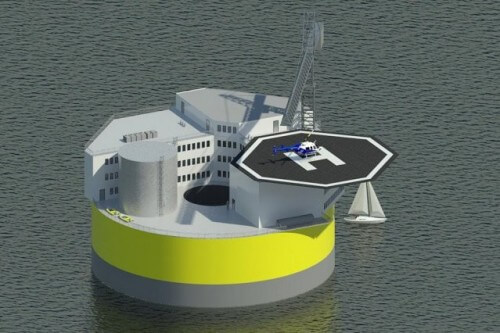Power plants, modeled after oil drilling rigs, will be designed so that their nuclear reactor is automatically cooled by the surrounding seawater in the event of a disaster. In this way, melting of the fuel rods or leakage of radioactive materials will be avoided

When an earthquake and tsunami hit the Daiichi nuclear power plant complex in Fukushima in 2011, it was neither the earthquake nor the flooding that caused the contamination. It was the side effects, in particular the lack of cooling for the reactor cores due to the interruption of all electricity at the station, that caused the damage.
A new design of power plants built on floating platforms has been developed by MIT scientists. The stations are built according to a model of oil drilling rigs in order to prevent such phenomena in the future. Floating power stations will be designed so that they will be automatically cooled by the seawater that surrounds them in the event that the worst case scenario occurs, so that the melting of fuel rods, or the leakage of radioactive materials, will be avoided.
The design was presented this week at a symposium dealing with modular nuclear reactors organized by the American Society of Mechanical Engineering, by Prof. Jacobo Bongiorno, Michael Golay and Neil Toders from MIT together with partners from the University of Wisconsin and the Chicago Bridges and Iron Company, a manufacturer of nuclear power plants and rigs for various needs.
Such power plants, explains Bongiorno, can be built in shipyards, and float towards their destination 7-10 km from the coast, where they will be anchored to the seabed and connected to the land by an underwater electrical transmission cable. The idea utilizes two technologies: nuclear reactors that use light water and oil and gas drilling rigs. The system is designed to take minimal technological risks, said Bongiorno, a professor in the Department of Nuclear Engineering and Science (NSE) at MIT.
"Although the idea of a floating nuclear reactor is not new, for example Russia is currently building such a reactor right on a barge near one of its coasts, none of them is located far from the coast so that it can 'ride' on tsunami waves. Our design is much safer than any other." Bongiorno said.
A rig floated a few kilometers from the coast, in an area where the sea is about a hundred meters deep, it could avoid the effect of the tsunami movement. Earthquakes will not affect it at all. In the meantime, the main problem of operating nuclear power plants of the type common today in emergency conditions - overheating and the risk of melting, as happened in Fukushima, Chernobyl and the Three Mile Island, will be impossible at sea, said Bongiorno: "It will be very close to the open sea, which is a heat sink infinite, so that it can be passively cooled without intervention. The tank containing the reactor will be under water in any case.
Bongiorno enumerates several advantages. For example, today it is difficult and expensive to find suitable sites for the establishment of nuclear power plants. They must be near a river, lake or sea for the purpose of supplying cooling water, but the real estate areas on the beaches are in great demand. In contrast, the sites in the sea, which are out of sight from the coast, can be close to population centers to which the electricity will be supplied. "The ocean is cheap real estate," Bongiorno said.
In addition, at the end of the station's life, it will be possible to transfer the remaining nuclear material to a central site of the type where the nuclear reactors of the aircraft carriers and nuclear submarines are safely stored today.
According to him, there is no limit to the size of power plants of this type, they can produce from 50 megawatts to a thousand megawatts, like today's large facilities." The station will also meet all the standards required of terrestrial stations. Bongiorno adds that the main market for such stations will be in Asia, where there is a growing demand for energy sources, but on the other hand they are exposed to tsunami waves.

One response
An excellent idea. If there is a malfunction, it will also be possible to drag the reactor to a remote and deep place in the Pacific and throw it to a depth of 10 km.
Or you can drag it to a pre-prepared pit and throw it there. You can fill the bottom of the pit with unenriched uranium or a substance that suppresses nuclear activity so that if the core melts it will be diluted